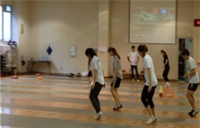PURPOSE The purpose of this study was to develop the estimating equations for 4 types of Wingate Anaerobic test setting. METHODS 80 male elite athletes performed 4 trials of the Wingate Anaerobic test by each type. Subjects were conducted the retest one week later. Data collected from the Wingate Anaerobic test included mean power, peak power, and power drop for 30s were measured. Coefficient of correlation was used for validity of type 1(DOS version) and the other types(ver. 2.24, 3.3.0, and 3.2.1). Pearson’s correlation coefficient was used to examine the reliability of test and retest. Simple regression analysis was used for calculating the estimating equation. RESULTS There was significant correlation for absolute value(Watt, p<.01) and relative value(Watt/kg, p<.01) of mean power, absolute value(W, p<.01), relative value(Watt/kg, p<.05), and power drop rate(%, p<.01). Test and retest reliability was excellent for all test variables(p<.01). CONCLUSIONS From the all results, the estimating equation was calculated to convert all outputs from each type to the other types of the Wingate Anaerobic test setting. These findings suggest that the estimating equations are compatiable to 4 types of Wingate Anaerobic test setting.
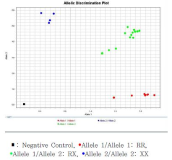
The ACTN3 R577X polymorphism has been associated with an elite athletes status. Several studies have determined that the R allele is connected with power-oriented athletic performance, whereas the nonfunctional XX genotype may give some beneficial effect for endurance performance. The main aim of the study was to determine the possible interaction between the ACTN3 R577X polymorphism and an power-oriented athlete status in Korean elite athletes(wrestling 31, judo 13, boxing 16, fencing 6, cycle 16, ≤400m athlete 18). Each athletes performed a 30-second WAPtest with a resistance equal to 7.5% for male and 5% for female body weight. Genotyping for the ACTN3 R577X (rs1815739) polymorphism was performed using the TaqMan approach. The ACTN3 R577X genotypes exhibited a HardyWeinberg equilibrium distribution in our population. The relative and absolute average power results of the 30-second Wingate test did not differ significantly among the genotypes. However, the relative peak power result of the Wingate test was significantly higher in the R-allele- dominant model groups than in the XX group in male but not female athletes. These results suggest that the ACTN3 R allele is associated with the relative peak power during the Wingate test in male Korean elite athletes.

Purpose This study was conducted to analyze the differences of physical characteristics focused on the physique, strength, and power for cycling national athletes (Sprint cyclists and Road race cyclists). Methods We measured various factors (e.g., height, weight, body fat ratio, thigh circumference, waist circumference, anaerobic power, isokinetic muscular strength, muscle power, squat jump by 1RM intensity, and so on) for a total 11 male cycling national athletes (5 Sprint cyclists and 6 Road race cyclists). Results First, the body composition showed the significant differences only in weight (p=0.31) and BMI (p=.001) for Sprint cyclists. Second, the values of the anaerobic power for the Sprint cyclists were significantly higher than those for the Road race cyclists only at peak power (p=0.28), whereas there was no significant difference in average power, isokinetic muscular strength, and muscle power between the two groups. Third, the isokinetic trunk flexion muscle (p = .016) for the Sprint cyclists were significantly higher than those for the Road race cyclists. Fourth, the significant difference in Time to Peak Torque was not found between two groups. Fifth, the values for the Sprint cyclists showed the significant difference in all 5 intensity groups (0%, 30%, 50%, 60%, and 80%) (p=.001) of the squat jump. Also, there was a statistically significant difference only in 0% velocity between the two groups, except for exercise intensity. Conclusions From the various measures between two groups, the Sprint cyclists relatively showed the high weight, BMI (muscle mass), and maximum power. Additionally, the isokinetic trunk flexion muscle and the squat jump were higher in the Sprint cyclists than the Road race cyclists. These data may be used as basic data to improve the physical fitness factors related to the athletic performance of the athletes by reflecting them in the effective training plan and evaluation of the athletes.
PURPOSE This study investigated the correlation between anaerobic power and maximum muscle strength in relation to core muscle strength among Korean national golfers. METHODS A total of 96 national golfers (53 females and 43 males) participated in the study. Body composition was assessed using multi-frequency impedance devices, while core and lower extremity muscle strength (extension, flexion, flex/ex ratio) was measured using isokinetic strength tests. Anaerobic power was evaluated through peak power, average power, and power drop rate tests conducted on bicycle ergometers, along with one-repetition maximum (1RM) tests for squats and bench presses. Mean and standard deviation values were calculated for all variables, and linear regression analysis was performed to verify correlations, with statistical significance set at α=.05. RESULTS The comparison of physical characteristics between male and female national golfers revealed significant differences in age, height, body fat percentage, lean body mass, and weight. There was a strong correlation between core muscle strength and isokinetic lower extremity muscle strength. Additionally, a strong correlation was observed between core muscle strength and anaerobic power and between peak power and average power. Furthermore, there was a high correlation between core muscle strength and bench press and squat maximum muscle strength. CONCLUSIONS This study highlights the correlation between various professional physical fitness variables of Korean national golfers over the past decade. The findings are expected to provide valuable insights for coaches and players in developing future training programs.

Purpose The purpose of this study was to examine the relationship between performance factors and physical fitness in secondary school female biathlon athletes. Participants in this study were 14 female biathlon athletes. Methods All factors such as aerobic capacity(VO2max, %AT), wingate test(peak power, average power, fatigue index), isokinetic test(trunk, knee, hip, ankle), 1RM test(leg press, chest press, lat pull down), physical fitness(grip, knee and back muscle strength, sit & reach, power, agility) were tested. In order to analyze collected data, pearson product moment and multiple regression analysis were utilized. The results were summarized as follows : First, there was a significant correlation between aerobic. Results The results were summarized as follows : First, there was a significant correlation between aerobic capacity and three factors(standing broad jump, isokinetic test 60° right knee extension)(p<.01). There was a significant correlation between wingate test and four factors(isokinetic test 30° left ankle ever, 30° right ankle ever, 120° left ankle inver, leg press)(p<.10). Conclusion These results suggested new evidence that ankle strength is necessary for performance in female biathlon athletes.

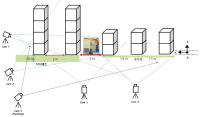
[Purpose] The purpose of this study was to compare Yeo 2 vault and YANG Hak Seon vault to verify the possibility of YANG Hak Seon vault. [Methods] The YANG Hak Seon vault and Yeo 2 vault performed by five Korean national gymnastic athletes, and the photographic images were collected using a high-speed camera and their kinematic characteristics were analyzed by 3D image analysis. [Results] The main variable of the post-flight phase S1, S4, and S2 were similar to YANG Hak Seon vault. S1 showed the largest at shoulder angle and the highest body center of mass at horse take-off. S4 showed the smallest shoulder angle at horse take-off, slow twisting at the post-flight ascending period, but faster femoral rotation during horse contact. S2 showed the slowest twist velocity in the ascending period of the post-flight and the smallest rotational distance and twist distance at the peak. S3 showed the slowest horse take-off velocity, the least time in the post-flight phase, and the hip joint was flexed at the peak. [Conclusions] S1 is required to increase the twist velocity by narrowing the shoulder angle during post-flight. S4 is required to strong push-up and an increase in the twisting velocity in the post-flight ascending period. S2 is required to shorten the horse contact time and increase the horse take-off angle through powerful femoral rotation after board take-off. S3 will have to get enough power from the preparation phase.

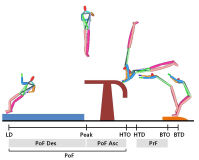


Purpose The purpose of this study was to determine the effectiveness of six-weeks intermittent hypoxic training at 3,000 m hypobaric hypoxic condition on aerobic and anaerobic exercise capacity in competitive swimmers. Methods South Korean swimmers (n=20) were randomly assigned into training at sea-level (n=10, intermittent normoxic training group; INT) and training at 526 torr corresponding to 3,000 m hypobaric hypoxic condition (n=10, intermittent hypoxic training group; IHT). The participants completed an aerobic continuous treadmill training (30 min) within 80%HRmax and anaerobic interval bicycle training (10 times; 2 min of exercise and 1 min of rest) for 30min within 90%HRmax in each environment. We compared their aerobic and anaerobic exercise capacity before and after six-weeks of training. Exercise frequency was 1 hour, 3 days per a week, and during 6 week. Results In aerobic exercise capacity, PWC at 75%HRmax, estimated VO2 max, and exercise time were increased by training in only the IHT group. Estimated VO2 at 75%HRmax was increased by training in both groups, but presented a larger increase tendency in the IHT group compared with the INT group. In anaerobic exercise capacity, peak anaerobic power and fatigue index were increased by training in only the IHT group. Blood lactate level after wingate test were decreased by training in both groups, but the IHT group have a lower blood lactate level in after training compared with the INT group. Conclusion In our study, we did not measure to various dependent variables for support to enhancement of aerobic and anaerobic exercise performance. However, these results showed that the IHT method may be effective in improvement of exercise performance in competitive swimmers who participates in a variety of events from short to long distance.
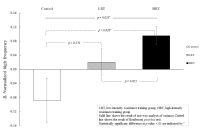
The purpose of this study is to investigate the influence of resistance training with different exercise intensities on heart rate variability(HRV) in habitual smokers. Twenty-eight healthy young smokers participated in this study were randomly divided into three groups; CON(control), LRT(low-intensity resistance training; 50% 1RM), and HRT(high-intensity resistance training; 70%1RM), respectively. LRT and HRT groups performed an 8-week resistance training(4 upper- and lower body exercises) using weight training machines, whereas CON group maintained their regular activities. All groups were evaluated basal body composition, hemodynamic parameters, HRV as autonomic nervous function, and muscular strength (1RM and isokinetic test) before and after the 8-week training. To assess the effect of 8-week training with different intensities on autonomic regulation, time and frequency domain indices of HRV were calculated from 5min R-R interval recording. As results, both LRT and HRT groups increased baseline 1RM and isokinetic strength compared to CON group. Meanwhile, high-frequency power reflecting parasympathetic activity was significantly increased in HRT compared to CON group. In addition, normalized low frequency power(LF nu) indicating a shift of sympathovagal balance towards sympathetic predominance significantly decreased while normalized high frequency power(HF nu) which reflects vagal predominance significantly increased in HRT compared to CON group. Furthermore, improved cardiac autonomic regulation and parasympathetic activation had significant association with increased muscular strength. Overall, the 8-week training has enhanced muscular strength in both training groups, particularly autonomic balance improved in young habitual smokers with high intensity resistance training.

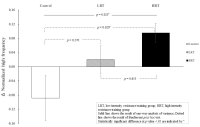
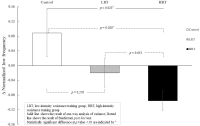
Purpose The purpose of this study was to find out the physical characteristics of Wushu athletes by comparing the differences on the results of physical fitness between the male athletes of the Wushu national team Taolu and the Sanda group. Methods Measurement of basic and professional fitness based on muscle function, targeting 37 men Wushu national team players (24 taolu, 13 Sanda) in the selection and evaluation contests twice in 2018 and 2019. Body composition, isometric muscle strength, flexibility and equilibrium, anaerobic power, and isokinetic muscle strength. The fitness factors were divided into two groups, Taolu and Sanda. Results First, body fat rate of the Sanda athlete group was significantly lower than that of the taolu athlete group (p<.01). Second, in the isometric muscle strength category(back muscle strength, grip strength), the Sanda athlete group had higher muscle strength than Taolu athlete group, but there was a statistically significant difference only in the left grip strength (p<.01). Third, in terms of flexibility and equilibrium, the taolu players were significantly higher in all items(p<.001). Fourth, in the anaerobic power, the taolu athlete group had higher both the peak power and the mean power, and there were a significant differences(peak power: p<.01, mean power: p<.001). Fifth, isokinetic muscle strength was significantly higher in the right knee flexion of the taolu athlete group (p<.01), and lumbar extensor muscle was significantly higher in the Sanda athlete group (p<.05). Sixth, in the isokinetic strength ratio, the knee flexion ratio of the Sanda athlete group were significantly higher on the left and right knee flexion and extensor ratios (p<.05). In addition, in the lumbar flexor and extensor ratios, the group of Sanda athlete group were significantly higher on the lumbar extensor(p<.05). Seventh, there was no significant difference between two groups in isokinetic muscle power. Conclusions The results of this study can be used as basic data to improve the efficiency of technical and physical training through the analysis of the characteristics of Taolu and Sanda. The effectiveness of this training will help to improve the performance.
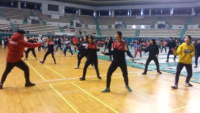
Purpose The purpose of this study was to investigate the effects of 3 weeks of fencing specific training on physical fitness in elite fencers. Methods Forty eight elite fencers participated in this program (Male= 24, Female= 24). Training program consists of dynamic stretching, step and agility training, and it was conducted with the general fencing practice during 3 weeks. Body composition and physical fitness (muscle strength/power, agility, anaerobic power and flexibility) were measured before and after training. Data were analyzed using IBM SPSS Statistics ver. 23.0 (IBM Co., Armonk, NY, USA). Paired t-test (pre vs. post) was used for comparison between groups. Results Muscle mass and body fat(%) were significantly changed after training in male group. Agility was significantly improved in change-step jump and reaction time after training both in male and female group. In Anaerobic power, peak power (relative power, absolute power) was significantly increased after training in female group. Flexibility was also significantly improved after training in left ankle ROM of female group. Conclusion Application of fencing specific training program focused on fencing movement seems to be effective on agility in both groups, muscle mass and body fat(%) in male group, and anaerobic power and flexibility in female group.

